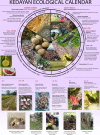The fading popularity of a local ecological calendar from Brunei Darussalam, Borneo
- PMID: 35429986
- PMCID: PMC9013451
- DOI: 10.1186/s13002-022-00525-9
The fading popularity of a local ecological calendar from Brunei Darussalam, Borneo
Abstract
Background: Local ecological calendars are ecocultural frameworks that link temporal and spatial scales, contributing to resilience and adaptive management of natural resources and landscapes. They also facilitate management, access and withdrawal of provisioning ecosystem services. In this article, we describe how the ecological calendar of the Kedayan people of Brunei Darussalam links skyscape and biodiversity with sociocultural aspirations to foster adaptive management of landscape, and provide an understanding of the transmission of calendric knowledge in the community.
Methods: In 2018, we collaborated with sixteen purposively sampled knowledge keepers from the Kedayan community of Brunei Darussalam to document the Kedayan local ecological calendar, and develop a calendrical pictogram. Using a structured questionnaire, we then interviewed 107 randomly selected community members, to understand the contemporary relevance and popularity of the Kedayan calendar, and the transmission of calendric knowledge in the community.
Results: Our findings reveal that very few respondents (n = 27, 25.3%) are aware of the existence of Kedayan ecological calendar; majority (n = 80, 74.7%) were not aware of its existence. There is no statistically significant correlation between consulting healers, knowledge on appropriate time requisite to consult healers, and awareness and self-professed knowledge of Kedayan calendar. Only 14 (13.1%) of the respondents reported to have received some form of calendric knowledge, while the majority (86.9%; n = 93) never received any calendric knowledge. Only a negligible 1.9% reported to have transmitted calendric knowledge to others indicating a breakdown in transmission of calendric knowledge.
Conclusion: The calendric pictogram would help the community in revitalizing their calendar. However, the community will have to invest on enhancing transmission of calendric knowledge.
Keywords: Calendar keeper; Ecosystem services; Indigenous calendar; Landscape management; Phenological knowledge.
© 2022. The Author(s).
Conflict of interest statement
The authors declare no competing interests.
Figures





References
-
- Maxwell ARJ. The place of the Kadayan in Traditional Brunei Society. South East Asia Res. 1996;4:157–196. doi: 10.1177/0967828X9600400204. - DOI
-
- Maxwell ARJ. Urang Darat, an ethnographic study of the Kadayan of Labu valley. Brunei: Yale University; 1981.
-
- Druce SC. A comparative analysis of the Brunei origin tradition with the wider Austronesian world. Origins, history and social structure in Brunei Darussalam. Abingdon, Oxon; New York: Routledge, 2021. |: Routledge; 2020. p. 42–56.
-
- Moody D. The Malayic language family. In: King J, King W, editors. Languages of Sabah: a survey report. Canberra: Australian National University; 1984. pp. 91–100.
-
- Sharbawi S. Reevaluating rhoticity in Brunei English: the case of the Kedayan. Southeast Asia A Multidiscip J. 2018;18:22–37.
MeSH terms
LinkOut - more resources
Full Text Sources

